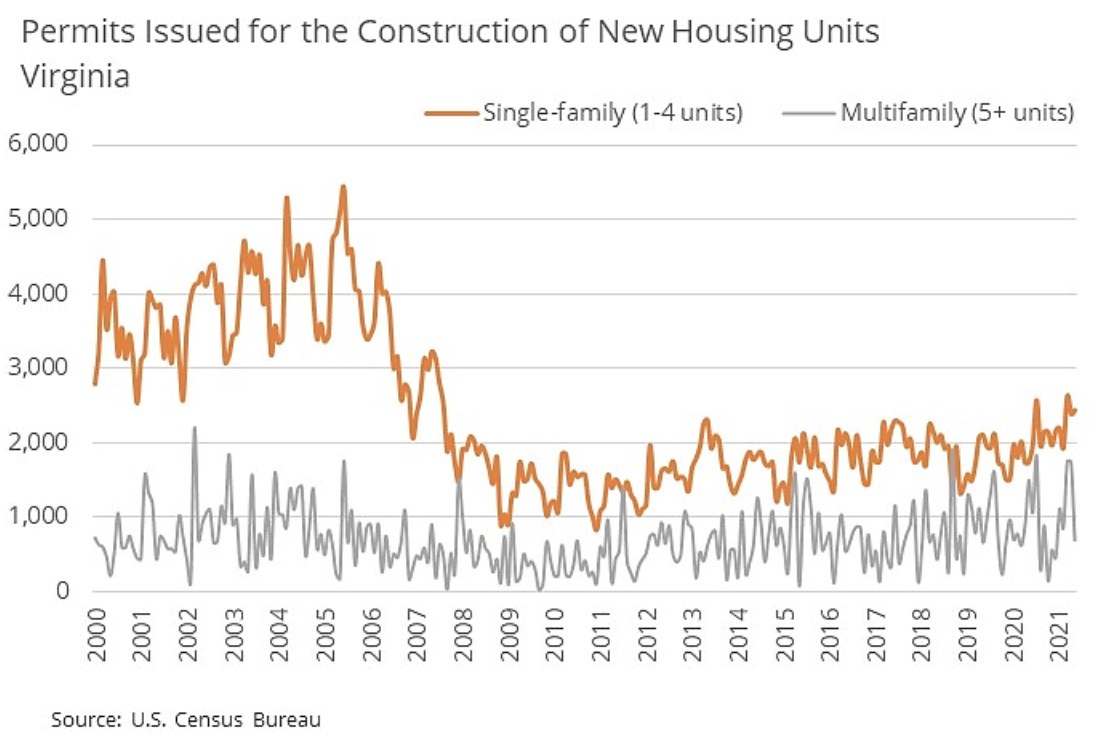New Housing Construction Up, Lumber Prices Down
June 30, 2021
Nationally, new home construction has hit a 15-year high, fueled by strong housing demand. In May, home builders started construction on new homes at a pace of 1.57 million annually, a 3.6% increase over April and 50.3% above the level in May 2020.
In Virginia, there were 3,125 permits issued for the construction of new residential units in May. Nearly 80% of permits were issued for the construction of single-family homes, while 20% were for units in multifamily buildings, including apartments and condominiums.
Like in many other places around the country, new home construction been on the rise in Virginia. In the first five months of 2021, there was a total of 17,685 permits issued for new housing construction in the state. By comparison, there were just 13,744 permits issued between January and May 2020. Year-to-date, the number of permits for new housing construction was up 28.7% compared to last year, with a 25.0% increase in single-family permits and a 36.3% increase in permits for multifamily housing units.

The cost of construction materials has been a major impediment to new construction. Lumber prices, in particular, surged to historically high levels during the COVID-19 pandemic. Back in March 2020, the futures price of lumber was $303 per thousand board feet. The cost more than quintupled over the past 14 months, reaching a high of $1,608 per thousand board feet in May 2021.
Lumber prices skyrocketed as a result of strong demand for new homes and a major interest in home renovations and DIY projects by people stuck at home. At the same time, supply chains have been disrupted by the pandemic and recession.
However, there is good news on the lumber costs issue. In June, prices fell below $900 per thousand board foot of lumber, reflecting a drop of 44.2% from the recent peak. The drop in lumber prices is good news for builders. Some new residential projects that have been put on hold could start back up again as costs fall.
Lumber prices are falling now as more sawmills have been able to open up more fully and ramp up production. In addition, the opening up of the economy means that more people are back at the office and are spending less time on DIY projects around the house which has led to slower demand from homeowners.
Falling materials costs (e.g., lumber, concrete, steel, brick/masonry) are a good sign for the home building industry and for consumers looking for more choices. However, there are still challenges to home building. The shortage of construction workers, limited building-ready lots, and zoning regulations that limit homebuilding will continue to be challenges to building enough housing to meet demand.
Click here to send any comments or questions about this piece to Virginia REALTORS® Chief Economist Lisa Sturtevant, PhD.
You might also like…
Midway Through 2024, Virginia Home Sales Activity Slightly Outpacing Last Year
By Robin Spensieri - July 24, 2024
According to the June 2024 Virginia Home Sales Report released by Virginia REALTORS®, there were 10,018 homes sold across the commonwealth last month. This is 974 fewer sales… Read More
Three Multifamily Market Trends from the Second Quarter of 2024
By Sejal Naik - July 16, 2024
Each quarter, through its Multifamily Market report, the research team at Virginia REALTORS® analyzes the trends and changes in the multifamily market. Here, we share the key highlights… Read More
Takeaways From the JCHS 2024 State of the Nation’s Housing
By Dominique Fair - July 15, 2024
The Joint Center for Housing Studies from Harvard University released this year’s State of the Nation’s Housing report highlighting the impact today’s market is having on both homeowners… Read More